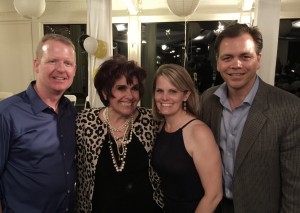Last night I had the privilege and honor to plan and execute a retirement party for a dear friend and colleague of mine. She has been teaching for 34 years and has decided to move into the next chapter of her life. I cannot convey what this woman has meant to me as a teacher and a person. I also had the opportunity to speak. I thought I’d share my speech here:
I met Tess in August of 2001. I had just moved here from Orange County and was checking out my new home at Cooley. I was with my mother and we were passing through the office. She grabbed my hand and exclaimed, “You’re German! We’re going to get along just fine.” And that we did. We were instantly connected mind and soul.
Over the years, I have learned many things from Tess. I thought I’d take my time tonight to highlight a few:
- Speak in analogies. Tess has an incredible ability to explain things in such a poetic way it not only creates a clear picture of what she is trying to say, but it also makes everything she says that much more interesting. One recent text I received reads: Wings work well in a flock or a single pattern.
- Use glitter. I remember my first year at Cooley, Tess had introduced our team to the Gift from the Heart project. Glitter, she says. The students need to use lots of glitter. I still have nightmares of drowning in rivers of glitter. But, the students LOVED it. She taught me that sometimes you just have to let teaching be messy, because, in the end, the sparkle will be worth it. In fact, when she sent me the guest list for tonight’s party, I opened the envelope, and sure enough: GLITTER.
- Cream Rises to the Top. When I got to Cooley, I had only been teaching six years. When I would come to her, fretting that I had botched a lesson or even ruined a child forever, she would assure me that the good things will always rise above the bad. Children will always remember the kindness we show them. The good can never go unnoticed.
- He’s a boy. I left teaching for eight years to be at home with my babies. I have a daughter, Stephanie, now 12, and a son, Jeffrey, soon to be 10. After Jeffrey was born, I remember complaining to Tess about the things he would do. He was nothing like my daughter. What was wrong with him? She would simply tell me that he’s a boy. He’d get there. There was nothing wrong with him. Boys are like Puppies, she’d say. They need to run, jump, bite things and maybe even bark at you.
- Go BIG: Tess taught me early on that nothing was worth doing if it was small. This was apparent when we decided to put on our first Renaissance Faire at Cooley. Not only did the every 7th grader out there in costume and guilds, we had a professional Blacksmith, archery and at one point a large scale trebuchet. This woman never does anything small. And her costumes! Always fit for royalty! If you’ve ever been to a Tess event, you know what I mean. Always a grand celebration!
- Nod, smile but do what’s in your heart. Tess taught me that following the way everyone else is doing something, isn’t always the path that’s right. Sometimes you have to follow your own passion. You have to open your own wings and let the wind take you where it may. You have to allow your students to do the same. But when someone asks you how that common assessment is going, simply smile and never let on that it’s still buried in a pile of papers on your desk. When you’re busy flying, you can’t worry about the ground.
- Cherish every day and every person you hold dear. This is probably the biggest lesson of all. I don’t get to see Tess as much as I’d like. In fact, it makes me a bit sad how little I do see her. But when I do, she always reminds me what’s important. It’s not our crazy schedules as parents or the endless papers to grade as teachers that make our life full. It’s the people we love. She always reminds me that no matter what happens, our time should be spent with the ones we love.
I have been blessed with knowing this incredible woman for over 14 years. She is a gift to me that I will hold dear until the end of time.
